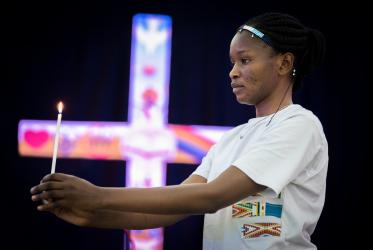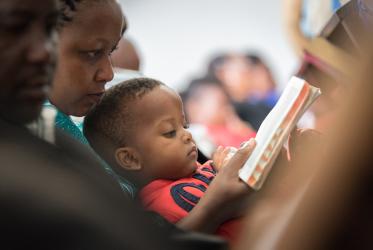In 2018 we celebrate the 70th anniversary of the World Council of Churches. In order to create a lively firsthand account of the ecumenical fellowship and of our shared journey, member churches have contributed stories of people, events, achievements and even failures, all of which have deepened our collective search for Christian unity.
This story was written by Ulrich Becker from Germany.
Any views or opinions expressed in this article are those of the authors, and do not necessarily reflect the policies of the World Council of Churches.
Normally, those who tell the story of the ecumenical movement begin with the first World Missionary Conference in Edinburgh in 1910 and with the Faith and Order and Life and Work movements that took shape soon thereafter. In this threefold division of the ecumenical movement during its pre-institutional phase, the precursor movements of the eighteenth and nineteenth centuries, which emerged from missionary and revival impetus, are often ignored. One of these was the Sunday school movement.
Its origins date back to the second half of the eighteenth century, when, during the Industrial Revolution in England, children who worked during the week were taken from the streets on Sundays and taught literacy and socialized through the Bible and catechism. This movement quickly spread to the European and North American continents with an increasingly missionary emphasis, and in the nineteenth century became an ever more familiar sight in mission fields as well.
The gatherings of leaders of the Sunday school movement at the national level beginning in 1791 were followed by those at the international level: the First World Sunday School Convention was held in London in 1889, and already received reports from 15 so-called mission countries. In 1907, the World Sunday School Association emerged from it, followed by the World Council of Christian Education in 1947 (in 1950 the World Council of Christian Education and Sunday School Association), with member organizations in 60 different countries.

Sunday School collection for returning refugees, Greece.
Photo: WCC
The task of these international associations was to advise interdenominational, regional, and national Sunday school groups and associations on teaching content and organizational matters, render financial support to them, promote work on shared curricula, study materials and training events, and maintain international contacts.
However, what is more important than enumerating the separate organizational steps and task areas of this great Sunday school movement is describing its significance for children and for those who worked in it. One eminently readable analysis of the history and theology of the American Sunday school movement notes:
Along with the biblical breast milk, millions of children also received the “cream“ of unity; faith and awareness came from that which was held in common. All later ecumenical “heroes“ – at least if they were Anglo-Saxons – came from this alma mater [of the Sunday school movement].
Certainly almost all Anglo-Saxon delegates at the World Missionary Conference in Edinburgh (1910) owed their first ecumenical steps and the foundations of their awareness of the unity of Christians to the “uniform lessons“, and some probably began their church careers as Sunday school assistants in exegetically interested preparatory committees and in monthly prayer meetings for the spread of Sunday schools to the ends of the world...
Thus, from the beginning ecumenism was a perspective in many American denominations – thanks to Sunday school. The Sunday school movement gained its worldwide and enviable unity and strength from the touching naivety of its biblicism in rejection of theological doctrine, in worldwide “uniformitas”, and in the joy of its own election and calling to teach and proclaim throughout the world. Its banner read: “Christian Unity”. “Narrow-minded” denominations were vigorously and proudly rejected, attacks were viewed as a confirmation, and visions of eschatological peace in unity were dreamed and pursued…
Unity “in nuce”, “communicatio in sacris”, “koinonia” and “unitas dei”, “union with Christ and each other” – these concepts took hold due to this experienced reality that transcends boundaries and removes barriers. What else should there be? Devoting oneself to God's Word was the rational service performed in the everyday life of the world – not in a theological ivory tower, often with marginalized, unreached people outside the churches. And all this built up God's kingdom. Was that not enough visible unity?
“Together with hundreds of thousands of my generation, I can say that I am, in a certain sense, a product of Sunday school,“ admitted Philip Potter, who was WCC general secretary for many years (1972-84).
Considering the fact that many ecumenical pioneers had attended Sunday school or worked in one locally or in its regional or international network, it is not surprising that the great ecumenical conferences held in the first half of the 20th century (from Edinburgh in 1910 until the formation of a provisional World Council of Churches in 1937-38) also addressed the issues of upbringing and education. It is also not surprising that cooperation between the WCC, which was founded definitively in 1948, and the World Council of Christian Education and Sunday School Association intensified thereafter. This finally led to the decision of the latter in 1971 to merge with the WCC. Its work was to be continued by the Office of Education, which was established at the WCC in 1969.
This also continued in the following years and reached its culmination at the Sixth WCC Assembly in Vancouver, Canada. Here, for the first time, children participated in the life of the assembly through various contributions. Just how important and effective these contributions were can be seen in, among other things, the fact that a child finally became the symbol of the assembly:
At the opening service, the plan was to have children and adults bring symbols of life to the altar. Suddenly, a young Zimbabwean mother also joined the procession with her child, who she had strapped to her back, and handed the child over the altar to the general secretary.
“At that moment, the grateful joy and anxious concern of all people over life on our endangered earth was gathered in this little child...In a fundamental way, Vancouver's theme was life on our earth. This is why the assembly had to address those in whom life is carried on: children." This is how one participant summed up this event.
For sources and further information see: Ulrich Becker, “Die ökumenische Bewegung als Anwalt des Kindes – oder: wie das Kind in die Ökumene kam”, in Jahrbuch für Kindertheologie, Band 5, Stuttgart 2006, p.49-55.
Further information on the 70th anniversary of the WCC
#WCC70: Stories from our common journey










